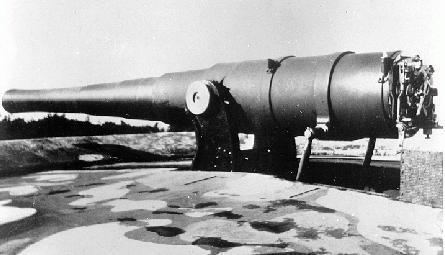Place of origin United Kingdom Wars World War I | In service 1881–1918 Variants Mk I – VII | |
 | ||
Type Naval gun
Coast defence gun Used by Royal Navy
Australian colonies | ||
The BL 9.2 inch guns Mk I – Mk VII were a family of early British heavy breechloading naval and coast defence guns in service from 1881 to the end of World War I. They were originally designed to use the old gunpowder propellants.
Contents
Mk I and II
British 9.2 inch guns originated from a request by the Admiralty in 1879 for a gun comparable to Krupp's 24 cm (9.45 inch) gun at the time. The Admiralty submitted its request to the Committee on Ordnance, which was considering returning to breech-loading artillery after Britain's brief return to muzzle-loaders in the 1860s and 1870s. A new breech-loading gun with a 9.2 inch (234 mm) bore, firing a 380-pound projectile was calculated to be suitable. A total of 19 Mk I and Mk II guns of 26 calibres were made starting in 1881, but after lengthy delays and modifications still proved unsatisfactory; none made it to sea.
Mk III – Mk VII
The 31.5 calibres versions, Mk III through to Mk VII became the first to be mounted on ships and deployed in general service.
Naval service
Guns equipped the following ships :
Coast defence gun
Most Mk IV guns and some Mk VI guns were used in coast defences.
In the mid-to-late 1880s successful trials were carried out with RML 9-inch coast-defence guns firing at high angles in order to test the effectiveness of plunging fire on decks of ships. When surplus BL 9.2 inch Mk IV and Mk VI guns became available in the 1890s they were likewise adapted to high-angle carriages, with their obsolete 3-motion breech mechanisms replaced by modern continuous-motion patterns to allow faster loading. Locations included Plymouth and Gibraltar.
The elevation of up to 45° meant that the shell was at risk of slipping back after being rammed forward; only the copper driving band held the shell in place in a BL gun, and they had not been designed to operate at such high angles. The solution adopted was to develop a special high-angle reduced-charge cartridge with a hollow up the centre, through which the gunner inserted a 1 1⁄4-inch-diameter (32 mm) stick about 40 inches long made of beech wood, to prevent the projectile from slipping back before firing. A "light" 290-pound (130 kg) shell was used for high-angle firing, rather than the standard 380-pound (170 kg) shell.
In the late 19th century to early 20th century five Mk IV coast-defence guns were installed at Singapore : two at Fort Connaught on Blakang Mati, one at Fort Siloso on Sentosa Island and two at Fort Pasir Panjang on Singapore Island. Two of these remain at Fort Siloso.
World War I railway gun
From 1915 onwards Elswick adapted a small number of Mk III, Mk IV and Mk VI guns, and mounted them on railway truck mountings for service on the Western Front in France and Belgium.
Australian service
In the late 1880s and early 1890s the Australian colonies between them ordered 10 barrels and nine carriages for BL 9.2 inch Mk VI 'counter bombardment' disappearing guns :
